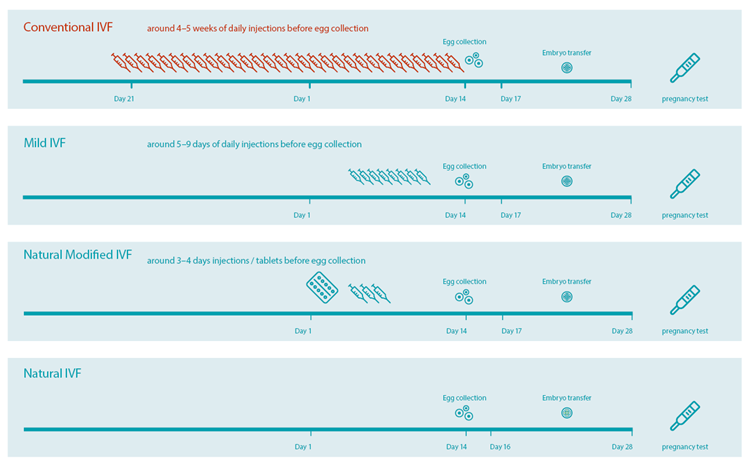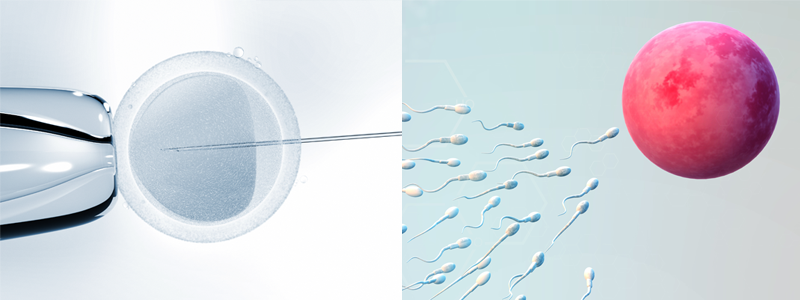What Is Short Protocol IVF?
When deciding which IVF treatment is best for you, at some point you will need to consider short protocol IVF against long protocol IVF. An example of this at CREATE Fertility is Mild IVF: a short protocol IVF cycle that lasts for a duration of 2 weeks, requiring patients to take drugs to stimulate the ovaries for just 5-9 days before egg collection, rather than the 4-5 weeks with the long protocols. Another benefit of the short protocol is that there’s no down-regulation. Mild IVF works within a woman’s natural cycle and avoids the potential menopausal side effects of down-regulation:
- Mood swings
- Hot flushes
- Disturbed sleep/ tiredness
- Night sweats
- Headaches
During both long and short protocols, you can expect a scan to collect information on how many eggs you produce, how healthy these eggs are and how easily an embryo can be implanted into the womb.
In the next steps, there are differences in the IVF procedure in the days and weeks leading up to egg collection:

Once the eggs are collected, they are mixed with your partner’s or donor sperm for fertilisation. If this is successful and an embryo has developed, it is transferred into the uterus in the hope that pregnancy will occur.
Read a patient’s experience of short protocol IVF at CREATE Fertility here.
Advantages of Short Protocol IVF
Because with Mild IVF and Natural IVF the wellbeing of the woman is the top priority, there are many benefits of short protocol IVF. The key advantages of short protocol IVF are:
- It focuses on eggs that only need gentle help to mature, meaning they will be high quality. A quality not quantity approach delivers great success rates
- Reduced chance of premature and/or low birth weight babies
- Because there are fewer drugs, there are less side effects and a shorter duration of treatment, meaning the procedure is less stressful and the patient experience is improved.
- Reduces the risk of Ovarian Hyperstimulation Syndrome (OHSS is a syndrome where the ovaries are overstimulated and swell up, causing pain, bloating and sometimes hospitalisation)
- It’s more affordable because we use lower doses of medication reducing the cost of treatment
Who is suitable for short protocol IVF?
Short protocol is suitable for women who are still ovulating and wish to reduce the side effects, length and risks of IVF treatment. In order for us to personalise your IVF treatment plan - designed to give you you the best possible chance of success - then please book an initial consultation with one of our experienced IVF consultants.
What is Long Protocol IVF?
Long protocol IVF, otherwise known as conventional IVF, has a much longer duration (4-6 weeks) which includes a period of down regulation and daily stimulating injections before egg collection. It’s recommended there be a 3 month break between each cycle and the treatment is often not viable for those with low ovarian reserve.
Problems:
With Conventional IVF, the goal is to create as many eggs as possible, therefore there are some disadvantages to this approach:
- In some cases, patients may develop OHSS as a result of stimulation injections. Symptoms include nausea, pain due to swollen ovaries, vomiting and in severe cases it can be fatal.
- Down regulation side effects can be difficult both physically and emotionally (Mood swings, hot flushes, disturbed sleep/ tiredness, night sweats, headaches)
- Longer treatment duration
- Less affordable as drug costs will be higher compared to short protocols.
Dr Geeta Nargund, Medical Director at CREATE Fertility spoke to The Express about the dangers of Conventional IVF: ‘We urgently need to take some radical action to reduce the risks faced by women undergoing IVF and their unborn babies. It is unacceptable for healthy women having treatment in order to have a baby to end up severely ill or admitted to hospital.’






